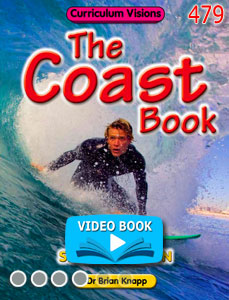A wave is a long ridge, or roll, of water that travels across the surface. When you drop a pebble on a pond it makes curved ridges of water we call ripples. Ripples are waves.
When the wind blows over the oceans, it makes some parts build up into ridges. These are ocean waves.
None of these deep-water waves have curling crests like the picture above. You only get those sort of features when a wave gets close to the coast. The huge waves that surfers love are called breaking waves, or breakers.
Breakers have many different shapes. In general storm waves cause steep-sided breakers to form, while great ocean waves - called swell waves - cause wider breakers to form. The picture shows an ocean swell-wave breaking.
If you look at the picture, you will see that the crest (top line) is pushing forwards. This is what pushes surfers forwards. But it also pushes sand and pebbles forwards.
If you were to look at a storm wave breaking, you would see that it breaks downwards, not forwards. So it does not send sand and pebbles up the beach. In fact, it often pulls them back off the beach.
When earthquakes occur under oceans, they shake the whole water very violently, and this sets up superwaves. These waves rear up when they reach the coast, and travel kilometres inland. They are called tsunamis.






